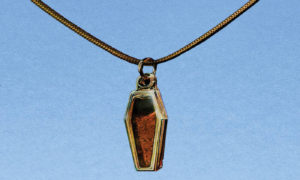In this interview, Kyle Schlesinger, published poet and proprietor of Cuneiform Press, talks with Michael Pierce, who recently released a solo cassette tape entitled Petty Interpretations, containing six covers of Tom Petty songs. Pierce is also the drummer for Austin punk band Dumb. Below, you can stream Pierce’s cover of “Refugee,” which features an important modification, preceding the interview transcription. -BCP
Kyle Schlesinger: You wrote about the dichotomy of comfort and meaning in Tom Petty’s “Refugee,” likening its lyrics to Paul Simon’s “Have a Good Time,” controverting that “some people do have to live like refugees, such as actual refugees.” The song came out in 1980, the dawn of the Regan administration, a very conservative decade in US politics and culture. As we stand on the verge of the most conservative administration ever, do you see your rendering of the song as a critique of Petty’s tune?
Michael Pierce: Yep.
KS: You mentioned that you started recording these songs, in part, because you wanted to create new arrangements without having to write lyrics at the same time, yet you’ve taken some interesting liberties with Petty’s words. Could you walk us through a couple of these modifications?
MP: Yeah, well really I just wanted to record and make something interesting, without having to actually, like, write songs. Full credit to Mark Janchar (DUMB, The Dumpies) for coming up with “you have to live like a refugee.” My process was basically to listen to Tom Petty for a while, pick a song I wanted to learn, and then wait until my mind associated it musically with another genre or another song. I knew I wanted to make one really sad song, and it was probably inevitable that I would try to sound like Natural Child at some point, and I fucking love The Spits.
KS: To me, the strangest subculture in rock is the tribute band. Their fidelity to the original version of the tunes they cover is extreme, sometimes even creepy. That approach is almost diametrically opposed to what I think of as a great tribute, that is, thinking of Jasper Johns’ “Take an object. Do something to it. Do something else to it.” Petty Interpretations opens with a rocking rendition of “Don’t Do Me Like That,” which is probably the most straightforward cover on the album—sorry, that’s a roundabout way of asking how you think about the difference between imitation and originality?
MP: Imitation for me is a way of learning and internalizing something you respect. Originality has to come from the heart, but hopefully the ideas you chose to internalize will rearrange themselves into something worthwhile. I just want to have fun making music. “Don’t Do Me Like That” was the first thing I recorded when I bought the Tascam. I did each track in one take. I knew there would be mistakes, it was the first time I’d really sang on a recording in years, and I wanted it to sound as shitty and real as possible so I never did a second take. I have a lot of respect for cover bands. I once saw David Garza extend a three-hour cover set to eight hours (at a wealthy man’s request) without repeating a single song. Talk about talent. Anyway, once you learn a song, the natural next step is to change the style. Great Jasper Johns quote. Exactly. Why not?
KS: Honestly, I think Tom Petty is pretty cheesy, and I’ve never liked “Running Down a Dream,” until now. It’s fucking beautiful Pierce! Is there a little raga influence? Why did you do that?
MP: The raga was inspired by my friend David Longoria (Longriver). He actually came by and helped me think through a few different ways to play the song fingerstyle. The original song mostly drones on the pedal tone of D, and a lot of John Fahey songs are in D, and a lot of Indian music happens to be in D. So it was kind of a no-brainer.
KS: You’ve worked ridiculously hard on this, and in the sincerest, most admirable way, it’s DIY. I know you work in the music industry, where success is measured by bean counters and bottom lines. Do you see this album as rebuttal against traditional notions of success, that whole larger-than-life rock star thing Petty embodies? How do you define success?
MP: There are a lot of tiers to the music biz. The best part about being in the completely-irrelevant-unknown tier is that you’re pretty much just making a record for your friends. I took a camping trip with some friends last year and it turned out our friend Grant knew a ton of Petty songs. He told me Petty and Lucinda Williams were his favorite songwriters. I’ve met a handful of people who tell me their whole family are diehard Petty fans. There’s something insidious about his songs, I hear them everywhere, mixed in with Taylor Swift and whoever. The songs have managed to remain relevant where even the Beatles and the Stones and Zeppelin aren’t played. His songs are innocuously American, but also amazing.
KS: It’s my understanding that you recorded this album on a four-track in your living room all by yourself using whatever instruments were within arm’s reach. Some artists go to great lengths to find the tools they need to actualize the vision in their minds, while others work with the materials that surround them. It seems to me that your approach is closer to the latter—could you talk about how you made Petty Interpretations?
MP: I’m not a rich guy. Let’s start there. I do own one really nice old Gibson acoustic guitar, but I’ve been trying to sell it for a while. I have a hundred-dollar Hohner acoustic that my stepdad gave me in ninth grade that actually has incredible action. I’ve played the same drum kit since my eighth birthday, and it was crappy even back then! My friend Bobby Bergland restores and collects vintage instruments. We were talking about Wurlitzers one day and I told him they are my favorite sound in the world, and that I’d always wanted to own one. A few months later he showed up at my house with this incredible Wurlitzer classroom electric piano from the early 60s, and asks if it would be a burden to store it at my house. That was five years ago! Bobby is a seriously cool dude. Also, I knew I would need some synth and organ sounds, so I found a Casiotone on Craigslist for $40. The electric guitar you hear is a really neglected Japanese no-name POS that Corey Baum traded to my roommate two years ago in exchange for a really nice Martin acoustic. My roommate is a pretty nice guy.
I will say, I was deliberate about the recording process. The Tascam 424mkII cassette recorder was at the center of everything, but I was able to cheaply rent a Rupert Neve channel-strip to feed it, and I own an old AKG 414 condenser microphone which has a very musical sound. I wanted everything going into the machine to be as hi-fi as possible. The fidelity of a cassette is surprisingly nice if you run the tape really fast.
The whole goal was to design a process of recording that would best support the final product. I’ve recorded on ProTools for years. Having so many choices tends to cripple the creative process, mainly I just don’t like looking at screens in my free time. I wanted to be able, on a whim, to run one XLR cable, put up a mic, hit record and start playing, without having to make any choices or wait for anything to load. The Tascam does that. At one point I plugged a 57 into a Rat distortion pedal and used the pedal as the mic-pre, straight into the Tascam. That’s the vocal on Refugee.
Separating the tracking process from the mixing process was really important to me. When you’re only doing one thing at a time, you can concentrate much better on each step, which supports the end result. Once everything was tracked, I unplugged the Tascam and took it to Joel’s Underwear, a studio run by my friend Joel Hume. It’s built in an acoustically tuned room, he’s got great Trident monitors, and the rest of his gear is pretty much a dream. All very high-end analog outboard gear centered around a Rupert Neve 5060. Pultecs, 1176s, more Neve, dual Roland Space Echos, it’s actually pretty ridiculous. All the reverb came from a Lexicon 300. I read a lot of TapeOp. I guess I’m a gear nut. We did all the mixing live (i.e. no edits, live effects throws and faders. At one point we had to enlist Matt McNeil and all three of us were pushing knobs and faders) into an Ampex 1/4″ reel-to-reel just like Petty would have done back in the day. It’s more fun to make a record, live, with your friends. Lastly we recorded the 1/4″ into the computer and that’s what you hear.










